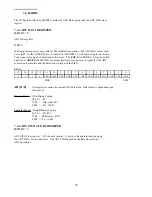
4.2.1 Common Ground / Single-Ended Inputs
Single-ended is the recommended configuration for common ground connections. However, if some of your inputs are
common ground and some are not, we recommend you use the differential mode. There is no performance penalty (other
than loss of channels) for using a differential input to measure a common ground signal source. However the reverse is not
true. The diagram below shows a recommended connection diagram for a common ground / single-ended input system
4.2.2 Common Ground / Differential Inputs
The use of differential inputs to monitor a signal source with a common ground is a acceptable configuration though it
requires more wiring and offers fewer channels than selecting a single-ended configuration. The diagram below shows the
recommended connections in this configuration.
4.2.3 Common Mode Voltage < +/-10V / Single-Ended Inputs
This is not a recommended configuration. In fact, the phrase common mode has no meaning in a single-ended system and
this case would be better described as a system with offset grounds. Anyway, you are welcome to try this configuration, no
system damage should occur and depending on the overall accuracy you require, you may receive acceptable results.
10
+
-
In p u t
A m p
To A /D
A /D B o a rd
I/O
C o n n e c to r
LL G N D
C H IN
S ig n
a l
S
o urce
w ith
C o
m m o n
G n d
O p tio nal w ire
since signa l sou rce
and A /D bo ard sh are
com m on g round
S ign a l so u rce an d A /D bo a rd
s ha ring c om m o n gro u n d con n e cte d
to s ing le -en d ed inp u t.
+
-
In p u t
A m p
To A /D
A /D B o a rd
I/O
C o n n e c to r
LL G N D
C H H igh
C H L ow
S ig n
al
S
o urc e
w ith
C
o m m
o n G n
d
O p tio nal w ire
since signa l sou rce
and A /D bo ard sha re
com m o n g round
R equ ired connection
of L L G N D to C H Low
S ign a l so urce an d A /D bo a rd
sha ring co m m o n gro u nd con n e cte d
to d iffe re ntia l in pu t.














































